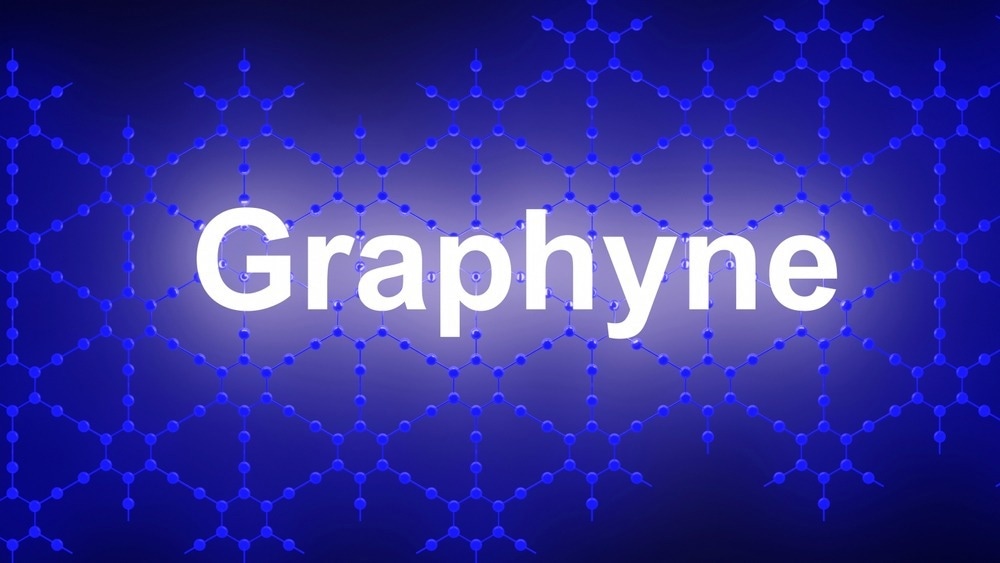γ-graphyne is a symmetrical carbon allotrope with sp1 and sp2 hybridized carbon atoms and is viewable when graphene expands uniformly with its aromatic rings separated by two-carbon acetylenic units. The synthesis of γ-graphyne in the form of an extended crystal lattice remains challenging.

Study: Scalable Synthesis and Characterization of Multilayer γ-Graphyne, New Carbon Crystals with a Small Direct Band Gap. Image Credit: MZinchenko/Shutterstock.com
Graphyne synthesis via irreversible coupling reactions often results in the formation of nanometre-scale materials that lack long-range order. An article published in the Journal of American Society reported the scalable fabrication of multilayer γ-graphyne via crystallization-assisted irreversible cross-coupling polymerization.
Here, the new carbon phase was characterized using various analytical methods. The results indicated that the prepared γ-graphyne was a semiconductor with a 0.48 electronvolts band gap and had a hexagonal α-axis and interlayer spacings of 6.88 angstroms and 3.48 angstroms, respectively, which aligned with the theoretical predictions.
Furthermore, the crystal structure of γ-graphyne had an aperiodic sheet stacking with thermal stability up to 240 degrees Celsius. The present work showed that a periodic covalent lattice could be built under purely kinetic control, compared to conventional two-dimensional (2D) polymerization and reticular chemistry, which depends on error correction based on reversibility. The proposed method is scalable and supports application to other graphyne family allotropes.
Synthesis of γ-Graphyne
Graphyne has electronic, mechanical, and optical properties comparable to graphene. Its chemical structure is composed of a combination of sp1 and sp2-hybridized carbon atoms with double and triple bonds within their framework. Graphynes are divided into graphynes-n with aromatic rings separated by the “n” number of acetylenic bonds and x-, y-, and z-graphynes with at least a few non-aromatic sp2 carbons.
γ-Graphyne is a fundamental homolog of graphyne-n (n = 1). Single-layered γ-graphyne is a semiconductor with a reasonable bandgap, rapid charge carrier mobility, excellent thermal conductivity, and outstanding strength. These characteristics suggest that γ-graphyne could be a foundation for next-generation carbon-based electronics.
Because acetylenes rapidly transform into graphene or amorphous carbon at high temperatures, the pyrolytic and vapor deposition procedures used for benzenoid carbon synthesis are inadequate for sp1-based structures. While templated solution-phase 2D polymerization has been established to create graphdiyne and graphdiyne-graphene heterostructures, a similar method has not been developed for γ-graphyne.
Previous reports on graphdiyne syntheses utilized the Glaser-Hay sp1–sp1 interaction to polymerize highly energetic hexaethynylbenzene confined to metal surfaces. Either coupling between the sp1 and sp2 carbons or de novo creation of three acetylenic bonds for each 12-DBA repeat unit would be necessary for a similar synthesis of γ-graphyne. The Sonogashira reaction is the most popular and all-purpose approach for sp1-sp2 C-C coupling.
Like other Pd-catalyzed cross-coupling reactions, the mechanism of the Sonogashira reaction process involves a homogeneous Pd0 catalytic cycle. Therefore, it is difficult to limit this chemistry to the template surface.
Synthesis of Multilayer γ‑Graphyne
The present work is based on the hypothesis that an efficient path to γ-graphyne and related stiff 2D polymers is via reactions that facilitate the formation of multiple chemical bonds in a single step or via a succession of kinetically connected quick steps.
The current approach toward γ-graphyne is the first report on an ordered covalent lattice spontaneously formed under kinetic control. In the present study, 1,3,5-tribromo-2,4,6-triethynylbenzene (TBTEB), an A3B3-type monomer, was prepared via an appropriately adjusted Sonogashira coupling reaction followed by its polymerization into γ-graphyne.
As each monomer unit "clicks" into place, this method would avoid the kinetic dead end of partially linked intermediates and endows a self-repairable polymerization. Defects in the developing lattice were the most reactive locations due to local strain and distortions, eased by multisite interaction with the monomer.
The two main goals of the current study were to develop a technique that facilitates the production of the required 2D lattice rather than disordered hyperbranched structures and to produce reaction conditions encouraging extensive coupling of the multifunctional TBTEB.
Conclusion
Overall, the current approach toward synthesizing γ-graphyne is the first report on an ordered covalent lattice spontaneously generated under kinetic control. Previous literature mentioned that irreversible polymerization of an A3B3-type monomer must only produce disordered branching structures when the reactivity is unaffected by geometry.
However, considering the frequently observed micron-scale γ-graphyne crystallites, random three-dimensional (3D) development was preferred over 2D polymerization, which was a kinetically favored crystallization. Additionally, this indicated that the first nucleation of flat graphene sheets was a highly probable event.
The excellent accuracy of the generated lattices implied that the system could repair faults despite the irreversibility of the Sonogashira coupling. Furthermore, the reaction proceeded relatively well at both the lattice edges and interior fault locations. These bond-forming processes were linked kinetically since "patching" a single internal flaw necessitates the creation of six new chemical bonds.
Reference
Desyatkin, V.G et al. (2022). Scalable Synthesis and Characterization of Multilayer γ-Graphyne, New Carbon Crystals with a Small Direct Band Gap. Journal of the American Chemical Society. https://pubs.acs.org/doi/10.1021/jacs.2c06583
Disclaimer: The views expressed here are those of the author expressed in their private capacity and do not necessarily represent the views of AZoM.com Limited T/A AZoNetwork the owner and operator of this website. This disclaimer forms part of the Terms and conditions of use of this website.